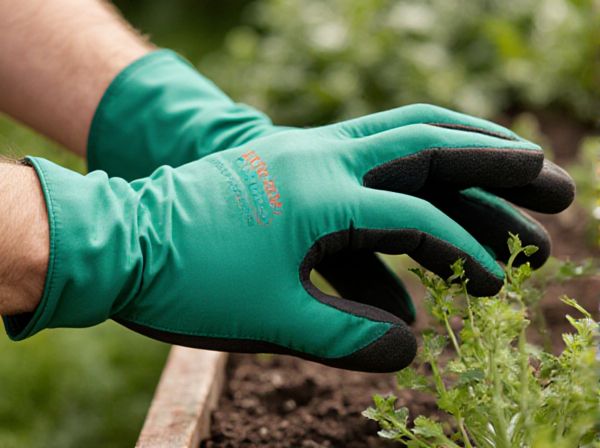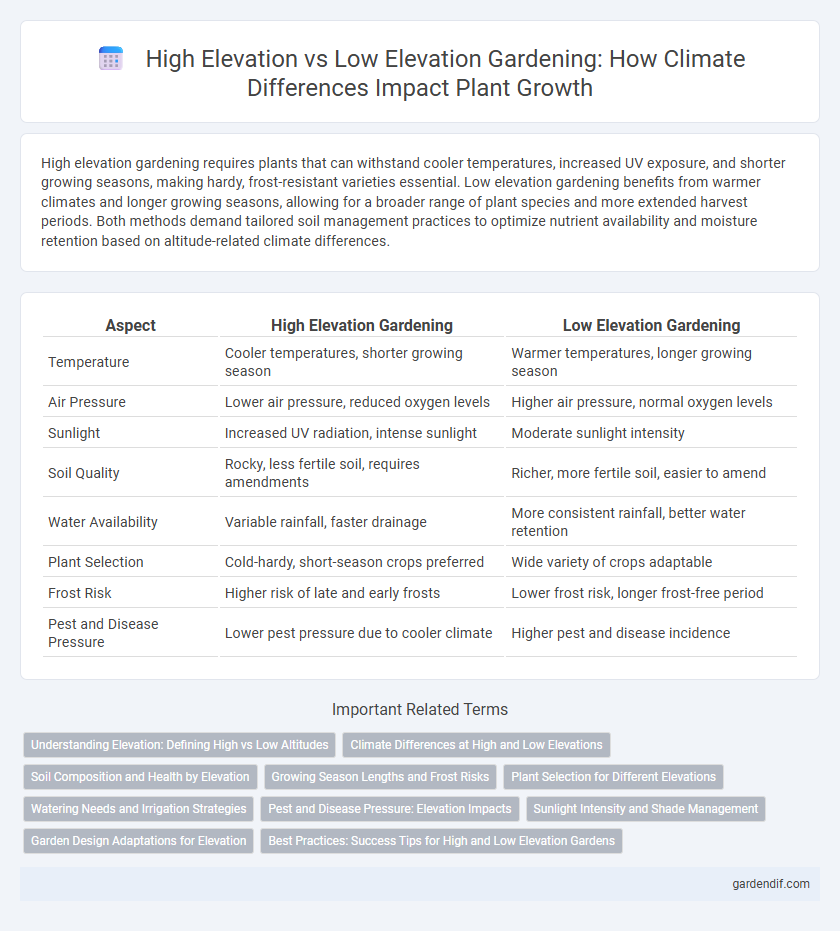
High Elevation Gardening vs Low Elevation Gardening Illustration
High elevation gardening requires plants that can withstand cooler temperatures, increased UV exposure, and shorter growing seasons, making hardy, frost-resistant varieties essential. Low elevation gardening benefits from warmer climates and longer growing seasons, allowing for a broader range of plant species and more extended harvest periods. Both methods demand tailored soil management practices to optimize nutrient availability and moisture retention based on altitude-related climate differences.
Table of Comparison
| Aspect | High Elevation Gardening | Low Elevation Gardening |
|---|---|---|
| Temperature | Cooler temperatures, shorter growing season | Warmer temperatures, longer growing season |
| Air Pressure | Lower air pressure, reduced oxygen levels | Higher air pressure, normal oxygen levels |
| Sunlight | Increased UV radiation, intense sunlight | Moderate sunlight intensity |
| Soil Quality | Rocky, less fertile soil, requires amendments | Richer, more fertile soil, easier to amend |
| Water Availability | Variable rainfall, faster drainage | More consistent rainfall, better water retention |
| Plant Selection | Cold-hardy, short-season crops preferred | Wide variety of crops adaptable |
| Frost Risk | Higher risk of late and early frosts | Lower frost risk, longer frost-free period |
| Pest and Disease Pressure | Lower pest pressure due to cooler climate | Higher pest and disease incidence |
Understanding Elevation: Defining High vs Low Altitudes
High elevation gardening typically occurs above 3,000 feet, where temperatures are cooler, the growing season is shorter, and plants must tolerate increased UV radiation and lower atmospheric pressure. Low elevation gardening usually takes place below 1,500 feet, featuring warmer climates, longer growing seasons, and higher air pressure that supports a broader variety of crops. Understanding these elevation distinctions is critical for selecting suitable plant species and optimizing growth conditions in different altitudes.
Climate Differences at High and Low Elevations
High elevation gardening experiences cooler temperatures, shorter growing seasons, and increased UV radiation compared to low elevation gardening, which benefits from warmer climates and longer growing periods. Soil composition and moisture levels also vary, with high elevations often having rocky, well-drained soils, while low elevations typically offer richer, more fertile soil. These climatic differences significantly influence plant selection, growth cycles, and garden management strategies at varying altitudes.
Soil Composition and Health by Elevation
Soil composition in high elevation gardening tends to be rockier and less fertile, with lower organic matter and slower microbial activity due to cooler temperatures, challenging plant nutrient availability. Low elevation soils usually have richer organic content, better moisture retention, and more active microbial communities, promoting healthier soil ecosystems that support diverse plant growth. Understanding these elevation-driven differences is crucial for optimizing soil amendments and cultivating resilient gardens adapted to specific climatic conditions.
Growing Season Lengths and Frost Risks
High elevation gardening typically experiences shorter growing seasons and higher frost risks due to cooler temperatures and thinner air, limiting plant variety and yield. Low elevation gardening benefits from longer growing seasons and reduced frost occurrences, enabling a wider selection of crops and extended harvest periods. Understanding these differences is crucial for gardeners to select appropriate plant species and optimize growth conditions in varying altitudes.
Plant Selection for Different Elevations
High elevation gardening demands selecting cold-hardy, frost-resistant plants such as alpine strawberries, kale, and certain varieties of lettuce that thrive in shorter growing seasons and cooler temperatures. Low elevation gardening allows for a broader range of heat-tolerant crops like tomatoes, peppers, and eggplants that benefit from longer warm periods and higher humidity. Understanding microclimate variations and soil composition at different elevations optimizes plant growth and maximizes crop yield in diverse climatic conditions.
Watering Needs and Irrigation Strategies
High elevation gardening requires precise watering due to cooler temperatures and faster evaporation rates, necessitating drip irrigation or soaker hoses to maintain consistent soil moisture. Low elevation gardening benefits from warmer climates and often needs less frequent irrigation but demands strategies like mulch application and timed watering to prevent water loss through evaporation. Efficient water management practices tailored to elevation-specific microclimates optimize plant health and conserve resources.
Pest and Disease Pressure: Elevation Impacts
High elevation gardening experiences reduced pest and disease pressure due to cooler temperatures and lower humidity, which slow the reproduction and spread of many common pests and pathogens. In contrast, low elevation gardening often faces increased challenges from insects and fungal diseases, accelerated by warmer, more humid environments. Selecting crops resistant to local pests and implementing integrated pest management strategies tailored to elevation-specific conditions can improve plant health and crop yields.
Sunlight Intensity and Shade Management
High elevation gardening experiences stronger sunlight intensity due to thinner atmosphere, increasing UV exposure and requiring robust shade management techniques like shade cloth or strategic plant placement to prevent leaf scorch. Low elevation gardening encounters moderate sunlight but often faces prolonged heat exposure, needing different shade solutions such as taller companion plants to create microclimates. Understanding these variations in solar radiation and microclimate effects is crucial for optimizing plant health and yield in diverse elevation zones.
Garden Design Adaptations for Elevation
High elevation gardening requires design adaptations such as selecting cold-hardy plant species, implementing raised beds for better soil drainage, and using windbreaks to protect against strong alpine winds. In contrast, low elevation gardening allows for a broader variety of plants with less emphasis on frost resistance and simpler irrigation systems due to warmer temperatures. Elevation-driven microclimates significantly influence soil composition, water retention, and sunlight exposure, demanding tailored garden layouts for optimal plant growth and sustainability.
Best Practices: Success Tips for High and Low Elevation Gardens
High elevation gardening demands selecting cold-hardy plant varieties and employing techniques like raised beds with ample drainage to combat frost and shorter growing seasons. Low elevation gardens benefit from extended growing periods and warmer temperatures, allowing for a wider range of crops but require vigilant pest control and soil moisture management to prevent heat stress. Both elevation levels thrive best with soil testing, proper mulching, and tailored irrigation schedules to optimize plant health and yield.
High Elevation Gardening vs Low Elevation Gardening Infographic

 gardendif.com
gardendif.com